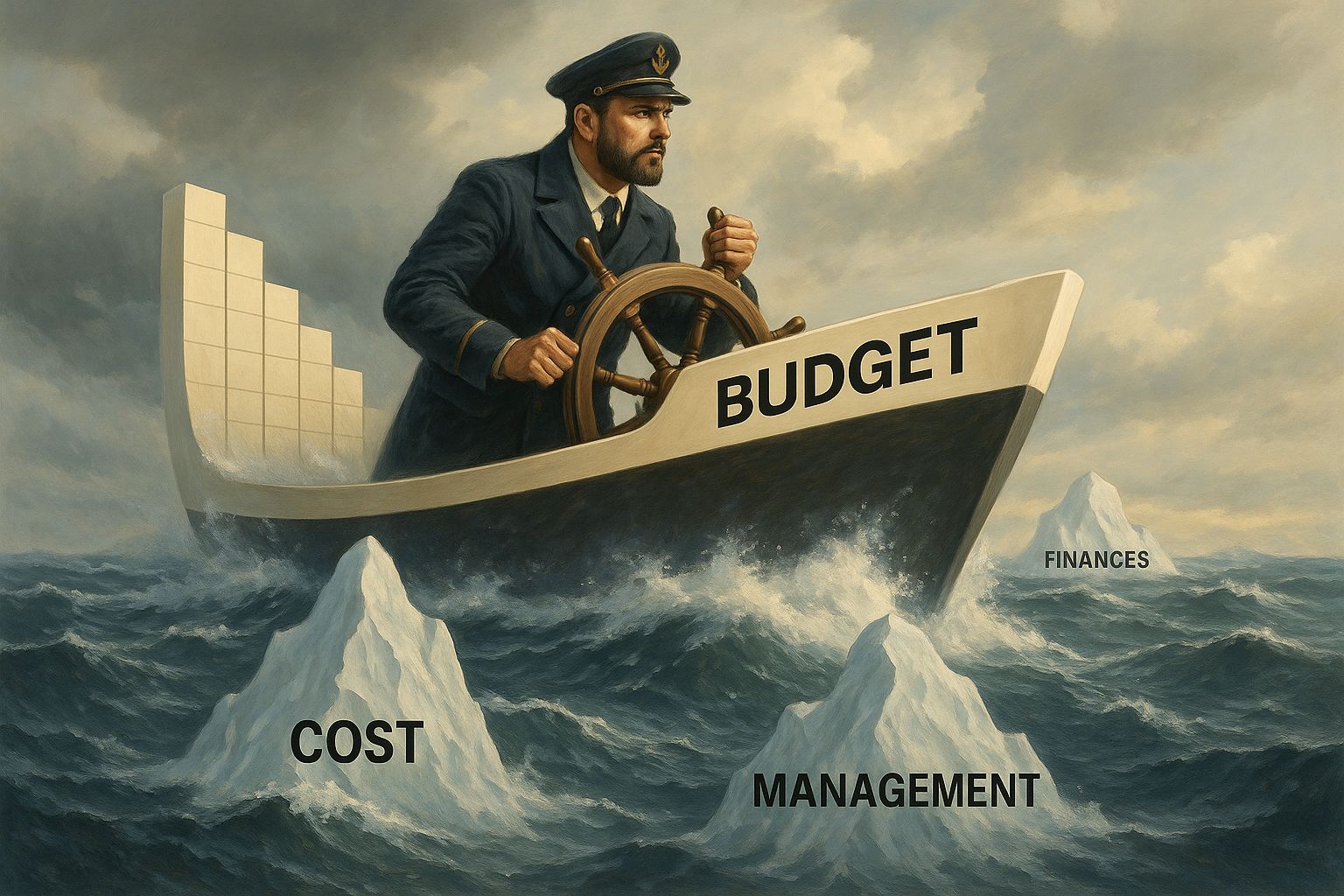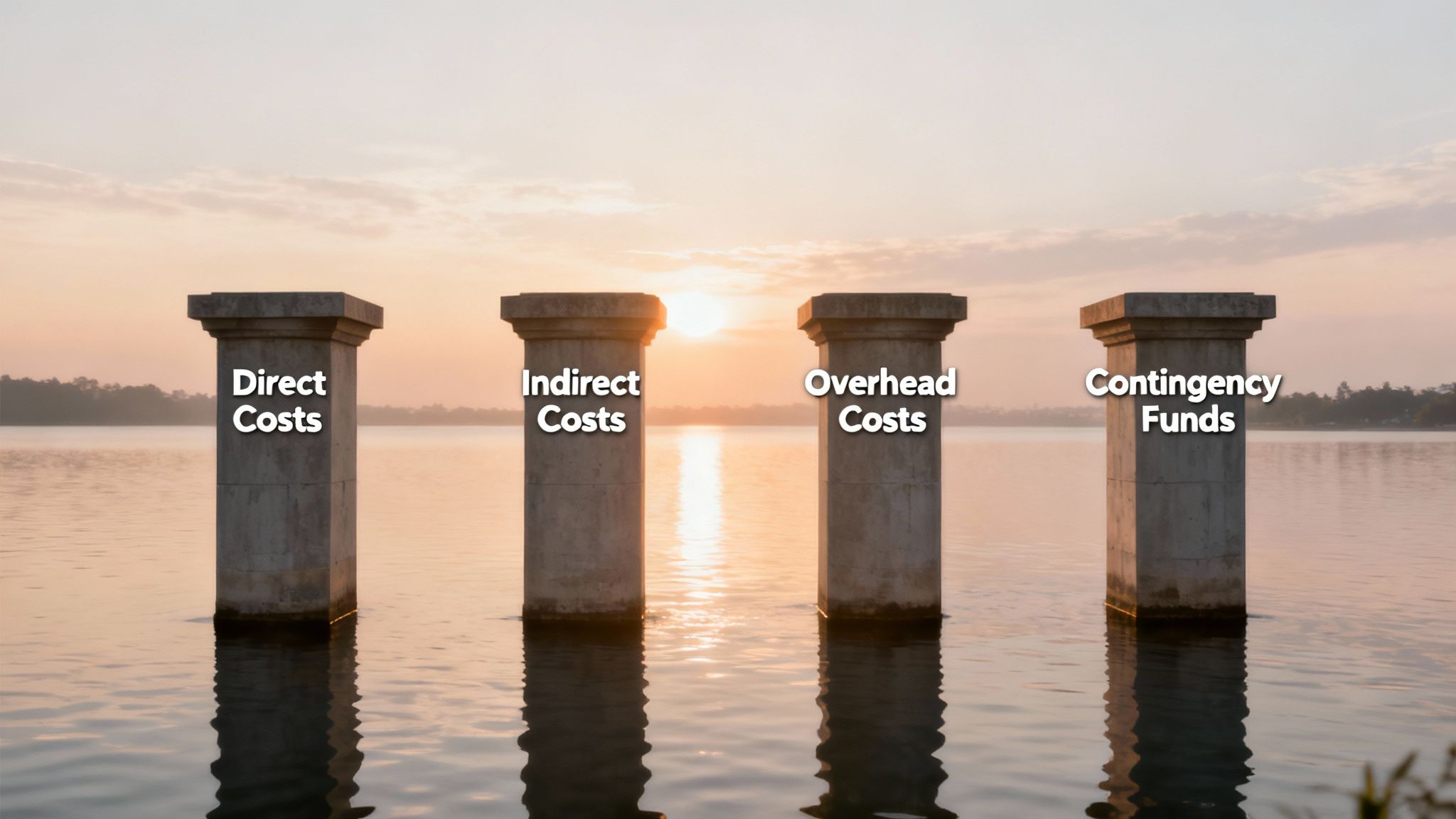Project management costs aren't just one line item you plug into a budget. Think of them as the entire financial ecosystem of your project—everything from the obvious expenses and hidden operational costs to the crucial "just in case" funds. It's the difference between knowing the price of a ticket for a ship's journey versus having the complete fuel and supply manifest.
Why Project Management Costs Are More Than a Line Item
Trying to manage project costs can feel less like simple accounting and more like navigating a ship through a storm. A sharp project manager is the captain, and the budget is their navigation chart. That chart is what helps them steer clear of financial icebergs—think scope creep and resource shortages—and guide the project safely to its destination. When you look at it this way, tracking costs stops being a chore and becomes a core strategic function that can make or break the project.
This perspective is so important because project costs are genuinely a complex ecosystem. They're not just about the checks you write for software or salaries. They also include all the less visible financial elements that are quietly keeping the project afloat.
The Full Financial Picture
To really get a grip on your project's financial health, you have to look past the obvious expenses. The complete picture is made up of three critical components:
- Direct Costs: These are the straightforward expenses you can point to and say, "this is for the project." Things like team salaries, software licenses, and any materials you need to buy.
- Indirect Costs: These are the shared, operational costs that keep the lights on—office rent, utilities, and administrative support that get allocated to the project.
- Contingency Funds: This is your project’s financial safety net. It's the cash you set aside for the unexpected risks and changes that always seem to pop up, no matter how well you plan.
Nailing down the difference between billable and non-billable hours is also a huge piece of this puzzle, especially since labor is often the biggest expense. For a deeper dive, check out our guide on billable vs non-billable hours.
By embracing this complete view, you shift from reactive problem-solving to proactive financial leadership. It’s the foundational step toward consistently delivering projects on time and, more importantly, under budget.
This infographic really brings this strategic approach to life, showing a project manager actively steering their budget through the stormy seas of financial risks.
The image drives home the point that successful cost management isn't just about passively tracking numbers; it's an active, ongoing process of navigation and adaptation.
Breaking Down the Four Pillars of Project Costs
Trying to manage project costs by lumping everything into one giant expense pool is like trying to navigate a city with a blank map. To get a real grip on your budget, you have to break it down. Think of it as creating a detailed financial blueprint for your project.
This blueprint is built on four fundamental pillars. Getting to know each one helps you see exactly where your money is going, spot potential savings, and make smarter calls when the pressure is on.
Pillar 1: Direct Costs
Direct costs are the most straightforward expenses you'll encounter. These are the costs you can point to and say, "This expense exists only because of this project." They're directly tied to producing the final deliverable and are usually the easiest to track.
For a software development project, this means the salaries of the developers, designers, and QA testers working exclusively on that product. It also includes any specific software licenses or cloud services bought just for this project. Without the project, these costs wouldn't exist.
In construction, direct costs are even more obvious. We're talking about raw materials like steel and concrete, the wages for the on-site crew, and the rental fees for heavy machinery like cranes and excavators.
Pillar 2: Indirect Costs
Indirect costs are the shared expenses that keep the business running, which are then allocated proportionally to your project. You'll often hear them called "overhead." While essential, they aren't tied to a single project's output—they're simply the cost of doing business.
Think about the office building where your software team works. The rent, utilities, and internet service are all indirect costs. Your project benefits from these things, so a slice of their cost gets attributed to your budget, even though they support the entire company.
Other examples include the salaries of administrative staff, general office supplies, and company-wide software for things like accounting or HR. Smart mastering projects with Smartsheet time tracking is crucial for allocating these costs accurately, and the right tools make this a whole lot simpler.
The key difference is traceability. If you can easily trace an expense to a specific project task, it's a direct cost. If it supports multiple projects or the entire organization, it's an indirect cost.
To make this distinction crystal clear, here’s a simple table comparing how these costs show up in different industries.
Direct vs. Indirect Project Cost Examples
| Cost Category | Software Development Example | Construction Project Example |
|---|---|---|
| Direct Costs | Salaries of dedicated developers, cost of a specific API subscription, user testing incentives. | Cost of lumber and concrete, wages for electricians, heavy equipment rental fees. |
| Indirect Costs | Office rent, electricity and internet bills, salaries of the HR and finance departments. | Corporate office lease, insurance policies, salaries for executive leadership. |
This table provides a quick reference for categorizing your expenses, helping you build a more accurate and transparent project budget from the start.
Pillar 3: Overhead Costs
While closely related to indirect costs, overhead costs often refer to the broader administrative and sales expenses needed to run the entire business. Think of them as the costs that keep the company's lights on, which are then partially assigned to individual projects.
This bucket includes everything from the marketing and sales team salaries to legal fees and company-wide insurance policies. These aren't just operational expenses; they're the core business functions that make projects possible in the first place.
Allocating these costs accurately is key to understanding a project's true profitability. A project might look great on paper based on direct costs alone, but once its share of the company's overhead is factored in, the financial picture can change in a hurry.
Pillar 4: Contingency Costs
The final pillar is your project's financial safety net. Contingency costs, sometimes called a contingency reserve, are funds set aside to handle unexpected events and risks. No project goes exactly according to plan, and this reserve is your planned response to the unplanned.
It’s critical to understand that a contingency fund is not a slush fund for scope creep or adding cool new features. It's a calculated amount, typically 5-10% of the total budget, meant to deal with identified risks that might pop up.
For instance, what if:
- A key developer gets sick, and you need to hire a temporary contractor?
- A critical software tool has an unexpected price hike?
- An unforeseen technical bug requires extra development hours to fix?
By planning for these possibilities with a contingency reserve, you can handle setbacks without derailing your entire budget and keep your project on stable financial ground.
How to Accurately Estimate Your Project Costs
Staring at a blank budget sheet can be a little intimidating. But here’s the thing: creating a solid cost estimate isn’t about pulling numbers out of thin air. It’s about following a structured process. A good estimate is the bedrock of any successful project, keeping you on budget and your stakeholders happy from day one.
The goal is to shift from a high-level guess to a detailed financial plan. Instead of winging it, experienced project managers use proven techniques to build an estimate that truly reflects the project's scope and complexity. Let’s walk through three of the most reliable methods out there.
Analogous Estimating: The Quick Comparison
Think of Analogous Estimating as making an educated guess based on what you’ve done before. It’s a top-down method where you look at a similar, completed project and use its final cost as a starting point for your new one.
For example, if you built a five-page marketing website for $15,000 last year, you might ballpark a similar project around the same figure. This technique is fast and doesn’t require a ton of data, which makes it perfect for those early stages when people just need a rough idea of the cost.
But that speed comes with a trade-off: precision. No two projects are ever truly identical, and this approach can easily miss key differences in scope, the team you’re using, or the tech involved. It’s a great way to get the conversation started, but it’s rarely sharp enough for the final budget.
Parametric Estimating: Using Data to Predict Costs
Parametric Estimating is a step up. It uses the statistical relationship between historical data points and other variables to get a more accurate number. Instead of looking at the project as one big chunk, you break it down and apply a known unit cost.
Let’s say you’re developing a new mobile app. Your past project data shows that, on average, a single feature costs $5,000 to design, build, and test. If the new app has ten features, your parametric estimate is a straightforward $50,000.
This approach is much more accurate than a simple analogy because it’s grounded in specific, measurable data. It shines in projects with lots of repeatable tasks, like:
- Construction: Calculating cost per square foot.
- Call Center Setup: Estimating the cost per workstation.
- Content Creation: Forecasting the cost per article or video produced.
The catch? The quality of your estimate depends entirely on the quality of your data. If your historical data is clean and well-organized, you’ll get a reliable number. This is where skills like building robust financial models become incredibly valuable.
Bottom-Up Estimating: The Most Detailed Approach
When you need the highest possible level of accuracy, it’s time for Bottom-Up Estimating. This is the most detailed and time-intensive method, but the result is a forecast you can truly stand behind. You start by breaking the entire project down into the smallest possible work items using a Work Breakdown Structure (WBS).
From there, you estimate the cost of every single one of those individual tasks and then add them all up. So, instead of estimating a "User Login Feature," you’d price out the costs for:
- Designing the UI/UX for the login screen.
- Developing the front-end components.
- Building the back-end authentication logic.
- Writing and running the QA tests.
This forces you to think through every single step, leaving very little room for nasty surprises down the road. It's crucial to involve your whole team here—the developers, designers, and testers doing the work are in the best position to estimate how long each piece will actually take.
Key Takeaway: While bottom-up estimating takes the most effort, it produces the most accurate and defensible budget. It turns cost estimation from a guess into a detailed, collaborative plan.
This kind of careful planning isn't just a "nice-to-have." Inefficiencies in project management have a real financial impact. Studies have shown that almost 10% of every dollar invested in projects is wasted due to poor performance. This often happens because roughly 42% of organizations don't place enough value on project management, which leads to high failure rates. You can find more project management statistics that drive home just how important this is.
Your Pre-Estimation Checklist
Before you jump in and start crunching numbers with any of these methods, make sure you've done your homework. A good estimate is built on a foundation of clear requirements and solid data.
- A Detailed Scope Statement: Do you have a clear, written document outlining exactly what the project will deliver?
- Work Breakdown Structure (WBS): Have you broken the project down into smaller, concrete tasks?
- Resource Plan: Do you know who’s working on the project and what their rates are?
- Historical Data: Can you get your hands on cost and time data from similar projects?
- Risk Register: Have you thought about what could go wrong and add unexpected costs?
Gathering this information first puts you in the best position to create a project cost estimate that you and your stakeholders can actually trust.
Mastering Project Cost Control And Reduction
Laying out a detailed budget feels like drawing a roadmap, but the real journey starts once you hit the road. A budget isn’t a dusty file—it’s a living document that guides every twist and turn in your project.
Cost control goes beyond logging expenses; it’s about predicting financial potholes, weighing smart trade-offs, and having clear protocols to adjust course. Nail these practices, and you’ll move from scrambling to put out budget fires to preventing them in the first place.
Use Earned Value Management For A Financial Pulse Check
Earned Value Management (EVM) is like the GPS for your project’s money and time. Instead of only comparing what you planned to spend against what you actually did, EVM layers in the value of work completed so far.
It stitches together scope, schedule, and cost data into easy-to-read metrics. You’ll know at a glance:
- Cost Performance Index (CPI): Are you getting the value you expected for every dollar spent?
- Schedule Performance Index (SPI): Are you ahead or behind based on the work done?
Spotting a mismatch early—say, 50% of budget used but only 30% of tasks done—gives you a heads-up to investigate. Maybe a process is slow or a resource needs support. Either way, you’ve got time to course-correct.
Implement A Formal Change Control Process
Scope creep can slip in like a slow leak and sink your budget. A formal change control process is your patch kit. It makes sure every tweak is:
- Logged
- Evaluated for its ripple effects
- Approved or turned down through an official channel
A change control process isn't about saying "no" to everything. It's about making conscious, informed decisions. It forces a conversation about trade-offs: "If we add this feature, we must either increase the budget or extend the deadline. Which is it?"
This framework turns scope discussions into transparent negotiations, protecting both your project’s integrity and its bottom line.
Proactive Strategies For Cost Reduction
Cutting costs doesn’t mean cutting corners. These tactics help you trim budgets without sacrificing quality:
- Strategic Vendor Negotiations: Dig into market rates, bundle related services, and secure milestone-based payments instead of big upfront fees.
- Resource Leveling: Smooth out peaks and valleys in your team’s workload to avoid burnout, rework, and expensive delays.
- Use Technology Wisely: Swap manual spreadsheets for tools that automate time and expense tracking. Real-time data on labor costs lets you pivot faster and free up your team for value-driving work.
By revisiting your budget often, sticking to a change control rhythm, and hunting for efficiency gains, you’ll steer your project to its finish line on time—and on budget.
Using Technology to Optimize Project Costs
Trying to manage project costs with spreadsheets in a fast-moving environment is a bit like navigating a highway with a paper map. Sure, you might get there eventually, but it's slow, full of potential wrong turns, and leaves you at a serious disadvantage. Modern project management software is the GPS you need—it's an absolute game-changer for getting a handle on expenses and boosting efficiency.
These platforms take you way beyond just reacting to expenses after the fact. They give you a real-time window into your spending, automate tedious jobs like time entry, and help you place your resources with surgical precision. It's this move from manual data entry to automated insights that really starts to unlock serious cost savings.
Pinpointing Your Biggest Cost Driver: Labor
For most service-based projects, labor is the single largest and most variable expense. It’s also the trickiest to control without solid data. When you're just guessing how long tasks take or who is working on what, you're practically inviting budget leaks and creating inaccurate forecasts. This is exactly where technology steps in with a powerful solution.
Specialized tools give you a crystal-clear view of how your team members are actually spending their time, swapping out vague estimates for concrete data. By automating time tracking, you get rid of the administrative headache and human error that comes with manual timesheets. This frees up your team to focus on productive, billable work instead of just filling out reports.
The real magic of this technology is clarity. It turns time—a fuzzy, abstract concept—into a measurable asset. You can see exactly where your biggest investment is going and figure out how to get the best possible return on it.
This clarity has a direct line to your ability to manage project management costs by finally connecting effort to actual outcomes.
How Automated Analytics Delivers Tangible Savings
Tools like TimeTackle are built to solve this exact problem. By plugging directly into your team's existing calendars, the platform automatically captures activities and uses analytics to surface insights you can't see otherwise. You can instantly see how much time is being spent on specific clients, projects, or even internal meetings.
This detailed data empowers you to:
- Improve Project Estimates: Base your future quotes on real historical data, not just a gut feeling. This leads directly to more profitable projects.
- Optimize Resource Allocation: Spot who's underutilized and who's overloaded. This lets you rebalance workloads to avoid burnout or unnecessary hiring.
- Increase Billing Accuracy: Make sure every single billable minute is captured. This stops revenue leakage and builds trust with your clients.
- Identify Inefficiencies: Quickly find time-sinks like too many internal meetings or repetitive admin tasks that can be streamlined or cut altogether.
The TimeTackle dashboard gives you a clean, at-a-glance view of these crucial metrics.
This visual breakdown makes it incredibly easy to spot trends in how your resources are being used, empowering you to make smart, data-driven decisions on the fly.
The Clear ROI of Investing in PM Software
The impact of adopting this kind of technology is hard to overstate. High-performing projects show a clear pattern: a whopping 77% of them use project management software. What's more, these tools have a direct effect on efficiency, with employees saving an average of 498 hours per year. That translates directly into massive labor cost reductions and far better time management.
A smart investment in technology like TimeTackle delivers a huge return by plugging budget leaks before they become disasters and making your entire team more efficient. For projects that rely heavily on data warehousing, it's also crucial to find ways to lower infrastructure costs, for instance by optimizing Snowflake for lower costs with the Snowpipe Streaming API. Integrating time tracking into your project management is a critical first step, and our ultimate guide to project management with time tracking can show you exactly how to get started.
Common Questions About Project Management Costs
When you're trying to get a handle on project finances, a few questions always seem to pop up. It's totally normal. Getting clear, practical answers to these is the key to managing your money with confidence and dodging the common traps that can sink an otherwise great plan.
Let’s break down some of the most frequent ones.
What Is the Difference Between a Cost Estimate and a Budget
This one trips people up all the time, but the distinction is pretty simple.
Think of a cost estimate as a well-educated guess. It’s your first pass at calculating what the project will likely cost, often given as a range to account for all the unknowns. You use this estimate in the early days to get buy-in from stakeholders before any real money is on the table.
A budget, on the other hand, is the official, approved amount of money you actually have to spend. Once your estimate gets the green light, it’s tightened up and formalized into the budget. This becomes your financial roadmap—the concrete plan you have to stick to.
In short, an estimate is the forecast you use to make your case. A budget is the authorized plan you’re accountable for delivering.
How Should You Handle Unexpected Costs During a Project
This is exactly why a contingency reserve isn't just a nice-to-have; it's a must. When a surprise cost inevitably hits, your first move shouldn’t be to panic. It’s to kick off your formal change control process. This isn't about dipping into a slush fund—it's a measured, professional response.
Here’s what that process looks like:
- Document the issue: Clearly write down what the unexpected cost is and where it came from.
- Assess the impact: Figure out exactly how this surprise affects the budget, the timeline, and the project's scope.
- Get approval: Take your findings to the stakeholders to get their official sign-off to use the contingency funds.
Following a structured process like this keeps everything transparent. It also ensures that your emergency fund is only used for genuine, unforeseen risks, not for quiet additions to the project's scope.
What Percentage of a Project Budget Should Be Labor Costs
Honestly, there’s no magic number here. The answer swings wildly depending on the industry you’re in.
For service-based industries like software development or a creative agency, it's not unusual for labor costs to eat up 70-80% of the total budget. People are your primary resource, after all.
But flip over to construction or manufacturing, where materials and heavy equipment are huge expenses, and labor might only make up 30-50% of the pie. The best approach is to look at the historical data from similar projects your own company has run. That’s how you’ll establish a benchmark that’s actually realistic for you.
Mastering your project's financial health starts with knowing where your time—and therefore, your money—is actually going. TimeTackle gives you the automated analytics to find that clarity, turning calendar data into powerful insights for smarter budgeting and resource planning. See how to get your project costs under control at https://www.timetackle.com.






